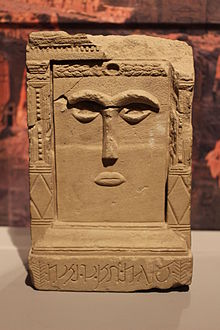User:HouseGecko/sandbox/1
| Al-'Uzza | |
|---|---|
 The idol from the Temple of the Winged Lions in Petra, probably of al-'Uzza | |
| Major cult center | Nakhla |
| Region | Arabia |
| Personal information | |
| Parents | Allah |
| Siblings | Al-Lat, Manāt |
| Consort | Dushara (Nabataean tradition) |
| Equivalents | |
| Greek equivalent | Aphrodite |
| Roman equivalent | Venus |
Al-'Uzza (Arabic: العزى al-ʻUzzā [al ʕuzzaː]), known as 'Uzzayan in south Arabia, is a pre-Islamic Arabian goddess who together with Al-Lat and Manat formed a triad of goddesses who were worshipped throughout Arabia.
Al-'Uzza was an important goddess of the Nabataeans, worshipped as a wife of Dushara. Under foreign influences, many goddesses, including Aphrodite and Isis, became identified with al-'Uzza. In Islamic tradition, al-'Uzza was the chief goddess of the Quraysh, a merchantile Arab tribe who became prominent in Mecca, and that her worship was ended with the destruction of the shrine at Nakhla.
Etymology and name[edit]
Al-'Uzza means "the Mightiest" in Arabic. It is related with the name of the male god 'Azizu (known in Greek as Azizos).
On the authority of Abd Allah ibn Abbas, at-Tabari derived al-'Uzza from al-'Aziz ("the Mighty"), one of the 99 "beautiful names of Allah" in his commentary on Qur'an 7:180.[1]
Attestations[edit]
Pre-Islamic era[edit]
Al-'Uzza was known in south Arabia as Uzzayan.[2] Her cult in south Arabia was widespread, and was far more significant than that of al-Lat and Manat.[2] The first sign of her cult comes from Qataban, dating from the 2nd century BC, and as an onomastic, she first appeared in the region in the 3rd century BC.[2] Evidence for her was found in twelve texts: five texts are commemorate offerings in one of her temples, two amulets invoke 'Uzzayan as a protectress, and three texts call upon her as the guardian of the royal palace of Qataban.[2] A south Arabian was said to have offered 'Uzzayan a golden image on behalf of her sick daughter, Amat-'Uzzayan ("the maid of 'Uzzayan").[3]
In north Arabia, al-'Uzza was believed to be a planetary goddess representing Venus, the morning star. She became an important goddess of the Nabataeans. Under foreign influences, al-'Uzza became identified with other goddesses. She was associated with Isis, an important Egyptian goddess at the time, as well as the Greek goddesses Aphrodite and Tyche. In Petra, a temple, known popularly as the Temple of the Winged Lions, may have been dedicated to al-'Uzza.
Islamic era[edit]
According to records of the Islamic period, al-'Uzza was worshipped by the Quraysh as their chief goddess. In Islamic sources regarding the battle of Uhud, the war-cry of the Quraysh was "O people of 'Uzza, people of Hubal!".
Reportedly, a shrine dedicated to her was set up at an area called Nakhla, between Ta'if and Mecca. The shrine's custodians were from the tribe of Banu Shayban, and was the site of three acacia trees where she was said to manifest in and thus were regarded as holy. According to Hisham ibn al-Kalbi, writing in his Book of Idols, she also had another shrine called Buss (or perhaps the shrine was located in a place called Buss), also known as the Kaaba of Ghatafan, where pilgrims would receive oracular communications.
The Book of Idols continues that near the Nakhla shrine, there was a place used for sacrifice called al-Ghabghab which was dedicated to al-'Uzza. According to some traditions, Muhammad, before his prophethood and acceptance of Islam, had sacrificed a white sheep for Al-'Uzza.
Ibn al-Kalbi describes her cult:
Over her [an Arab] built a house called Buss in which the people used to receive oracular communications. The Arabs as well as the Quraysh used to name their children "‘Abdu l-ʻUzzā". Furthermore, al-ʻUzzā was the greatest idol among the Quraysh. They used to journey to her, offer gifts unto her, and seek her favours through sacrifice.
The name 'Abd-al-'Uzza was a favorite proper name at the advent of Islam.[4]
The shrine at Nakhla was said to be destroyed shortly after the conquest of Mecca. In Islamic tradition, Muhammad sent Khalid ibn Al-Walid during Ramadan 630 AD (8 AH) to the shrine. The last custodian of the shrine was, who was killed during the raid. A naked black woman, wailing and grinding her teeth was also to be found.
Scholarly interpretations[edit]
Iconography[edit]

In Nabataean art, al-'Uzza is connected with a type of betyl with star-like eyes.
An ornate eye-idol found at the Temple of the Winged Lions, crowned with an Isian headdress, may depict al-'Uzza. Inscribed on the idol is "Goddess of Hayyan".
References[edit]
Citations[edit]
- ^ al-Kalbi 2013, p. 25.
- ^ a b c d Robin, Christian Julien, "South Arabia, Religions in Pre-Islamic", in McAuliffe 2005, pp. 88
- ^ Hitti 2002, p. 99.
- ^ Hitti 2002, p. 96-101.
Sources[edit]
- Healey, John F. (2001), The Religion of the Nabataeans: A Conspectus., Brill, ISBN 978-90-04-10754-0
- Hitti, Phillip K. (2002), History of The Arabs (Revised ed.), Macmillan International Higher Education, ISBN 9781137039828
- al-Kalbi, Ibn (2015), Book of Idols, translated by Faris, Nabih Amin, Princeton University Press, ISBN 978-1-4008-7679-2
- McAuliffe, Jane Dammen (2005), Encyclopaedia of the Qurʼān, vol. 5, Brill, ISBN 978-90-04-12356-4
